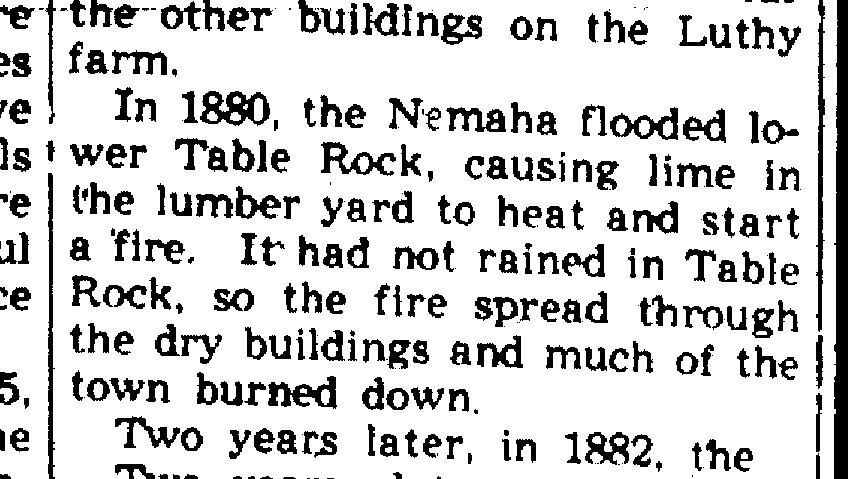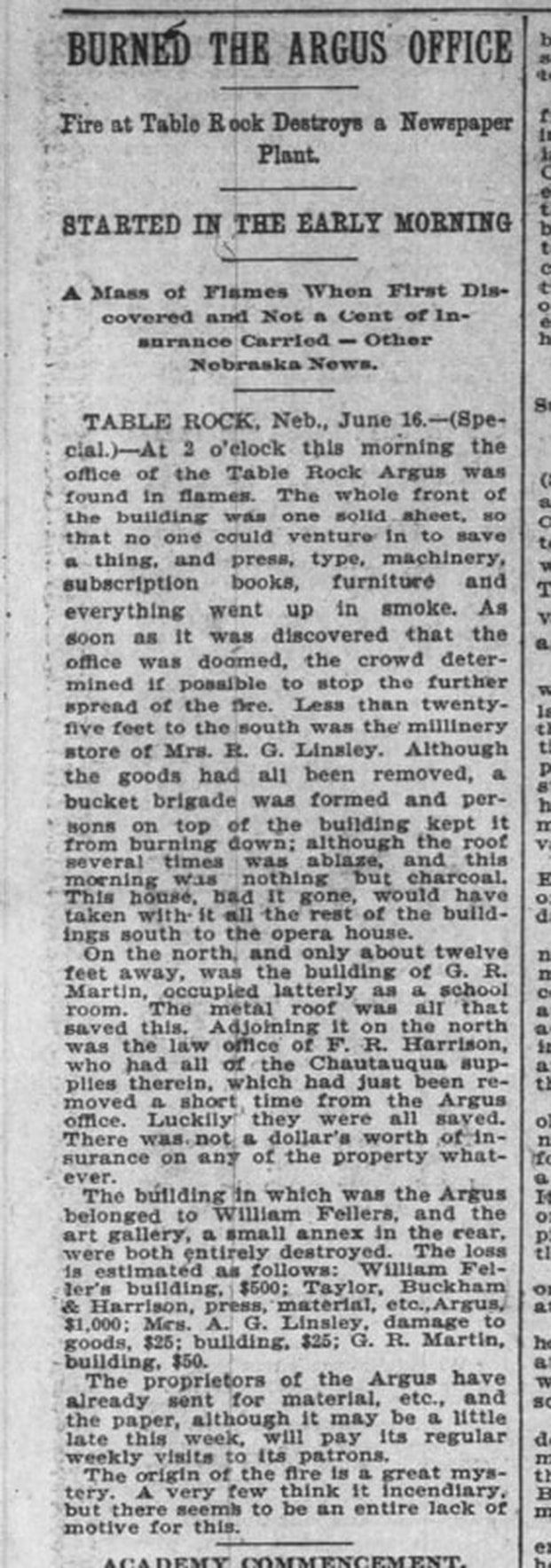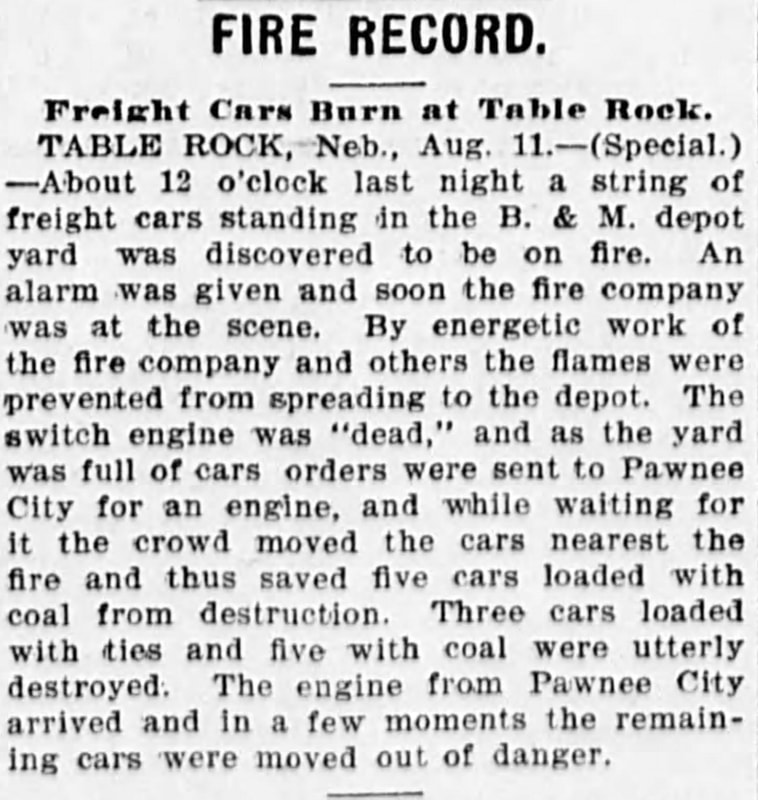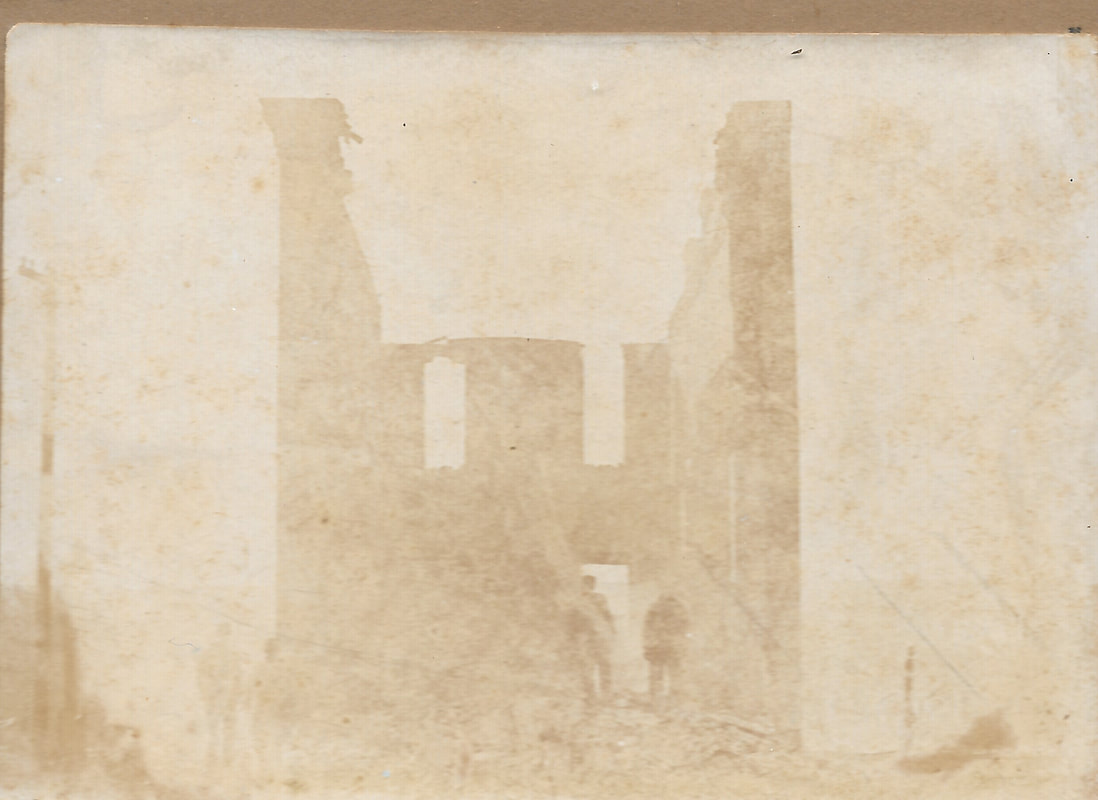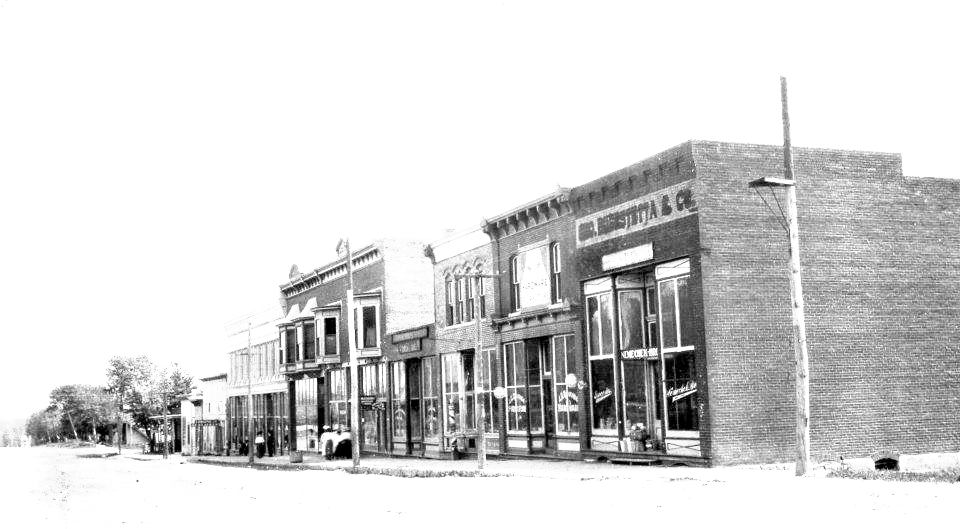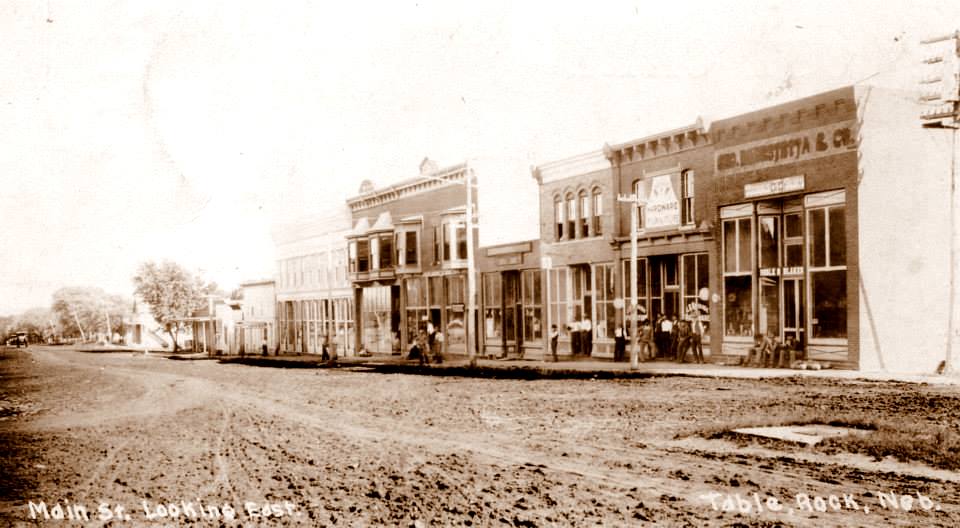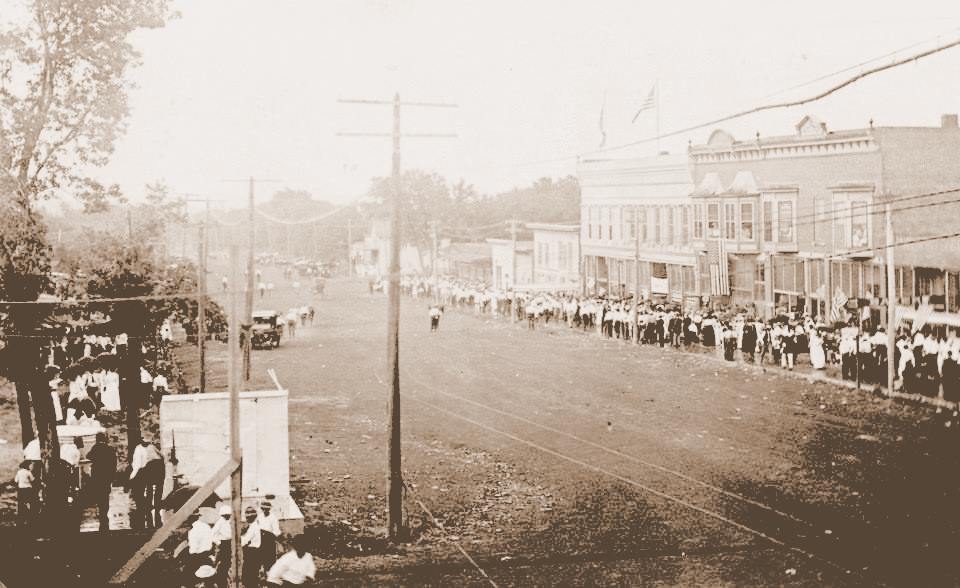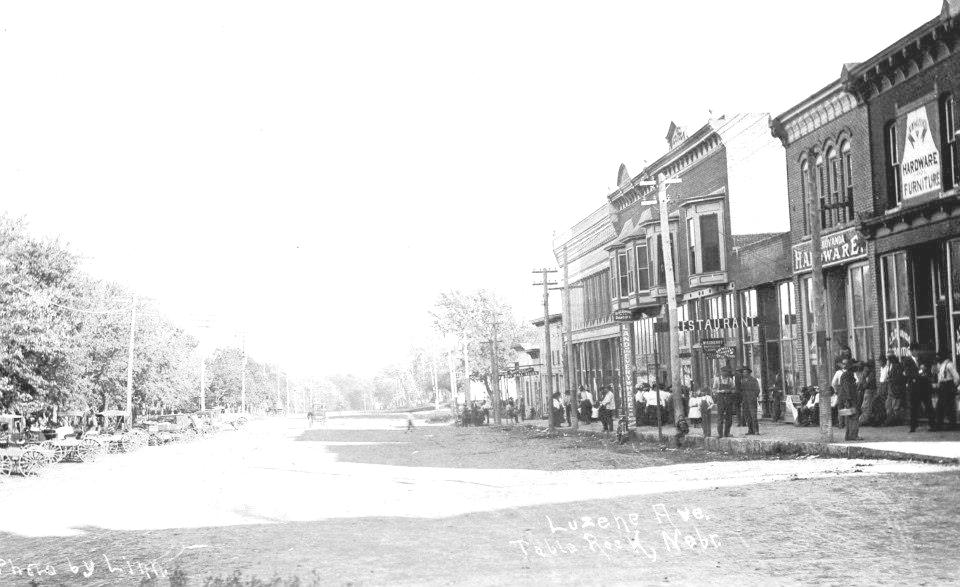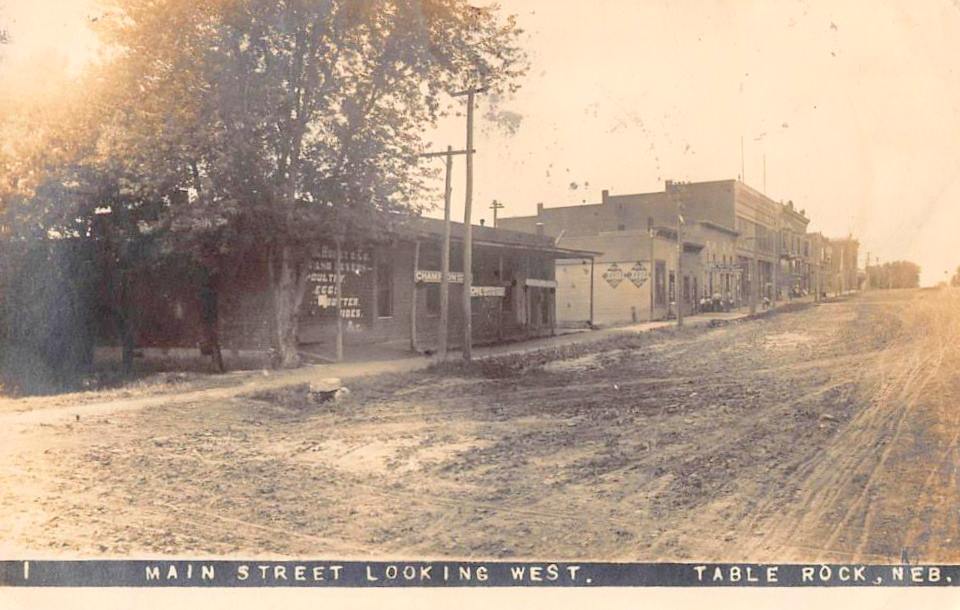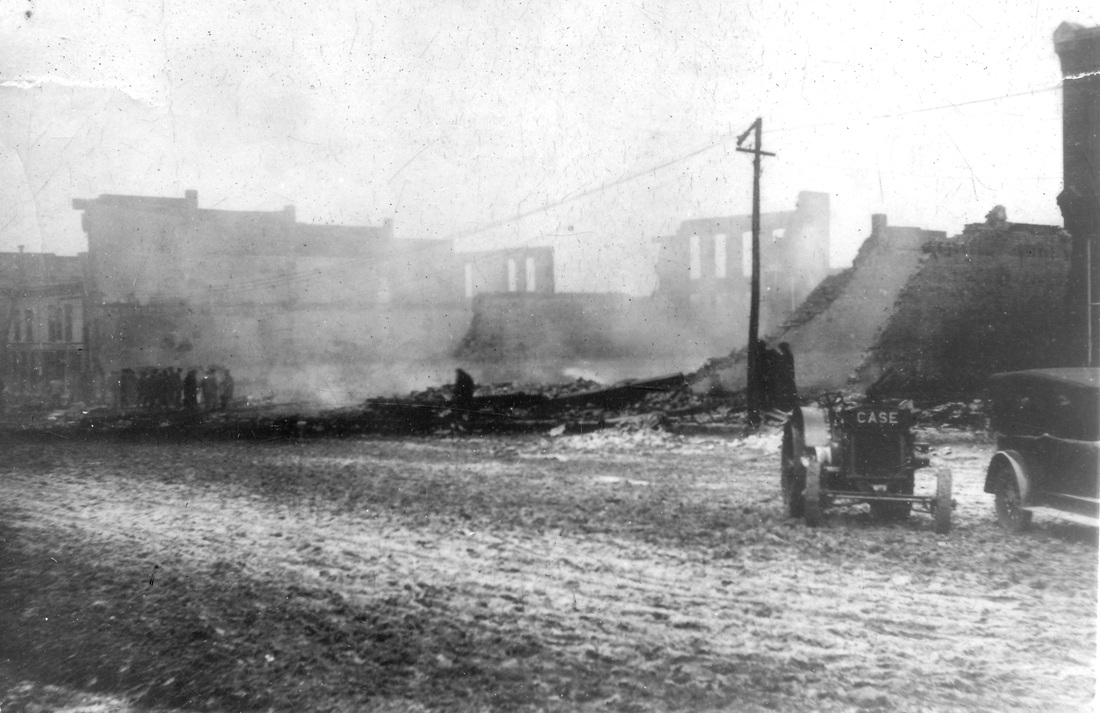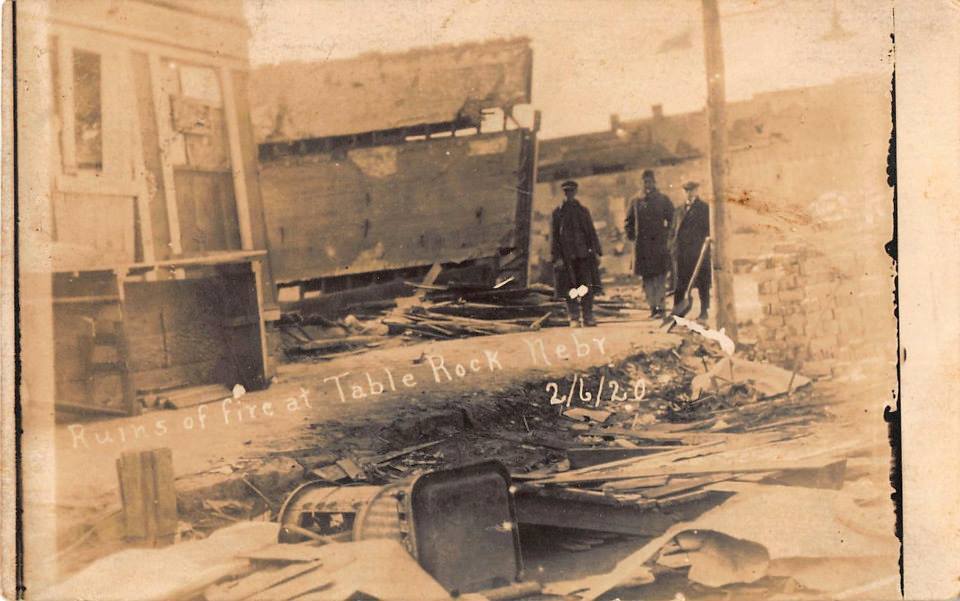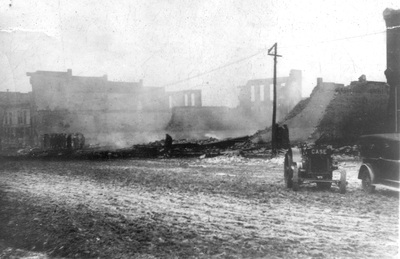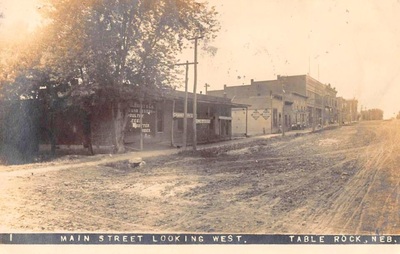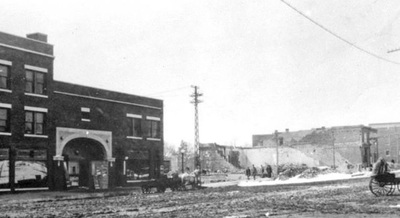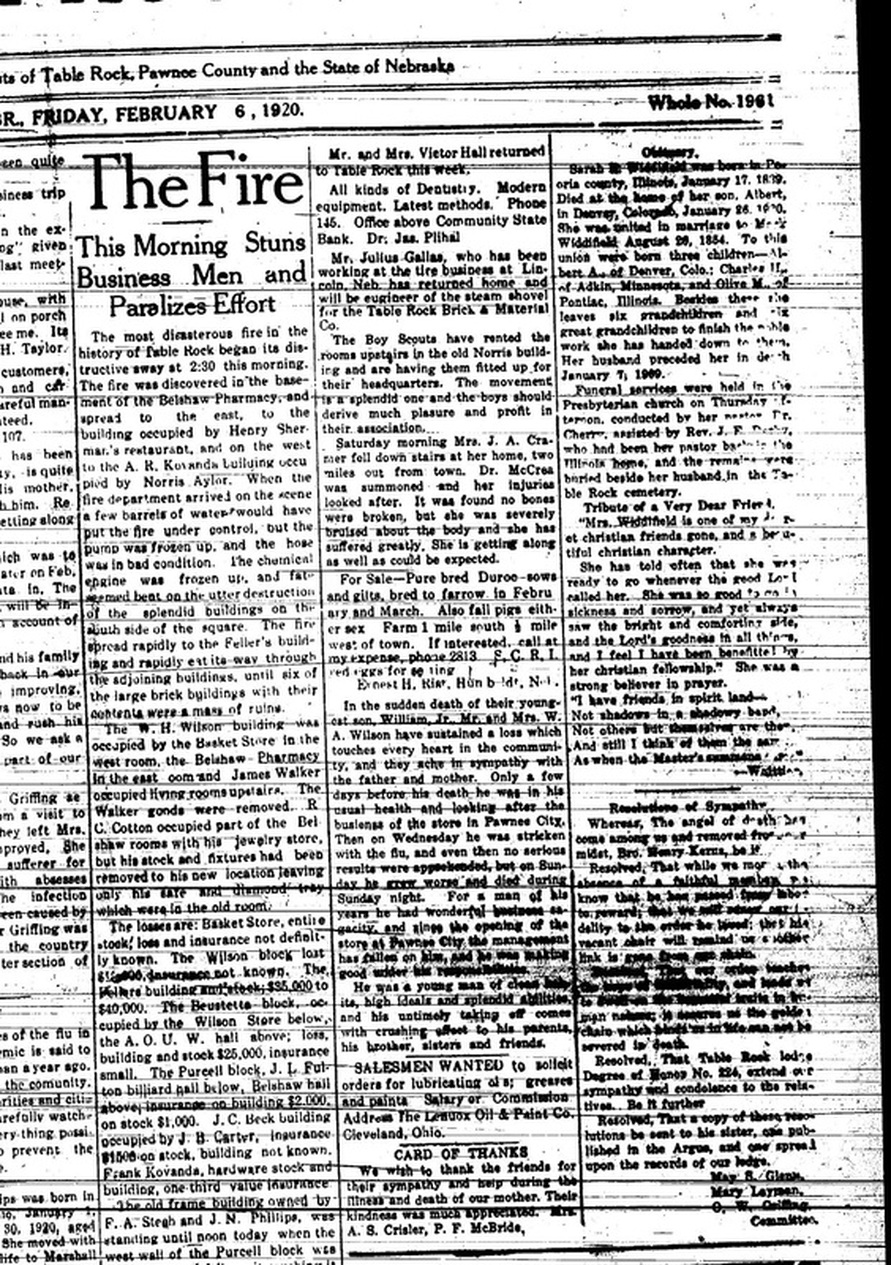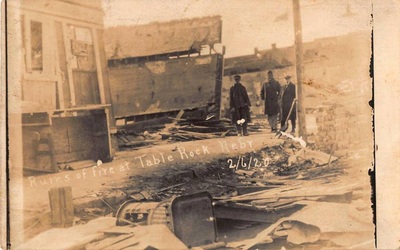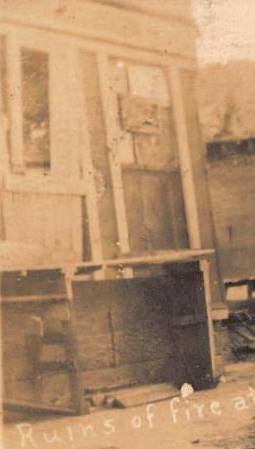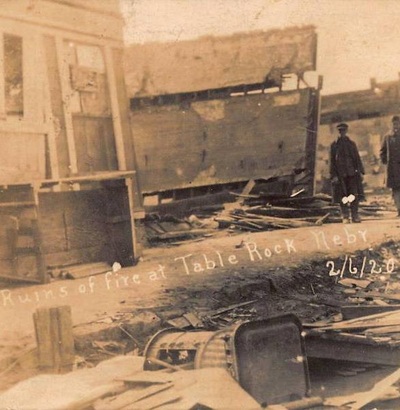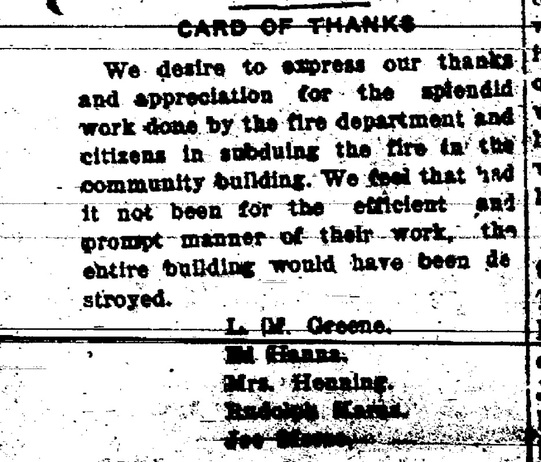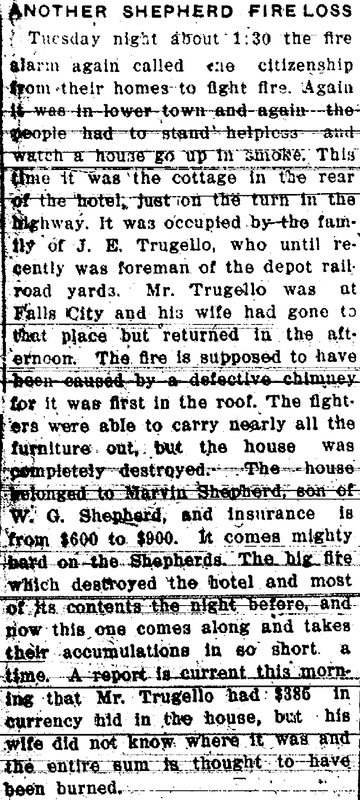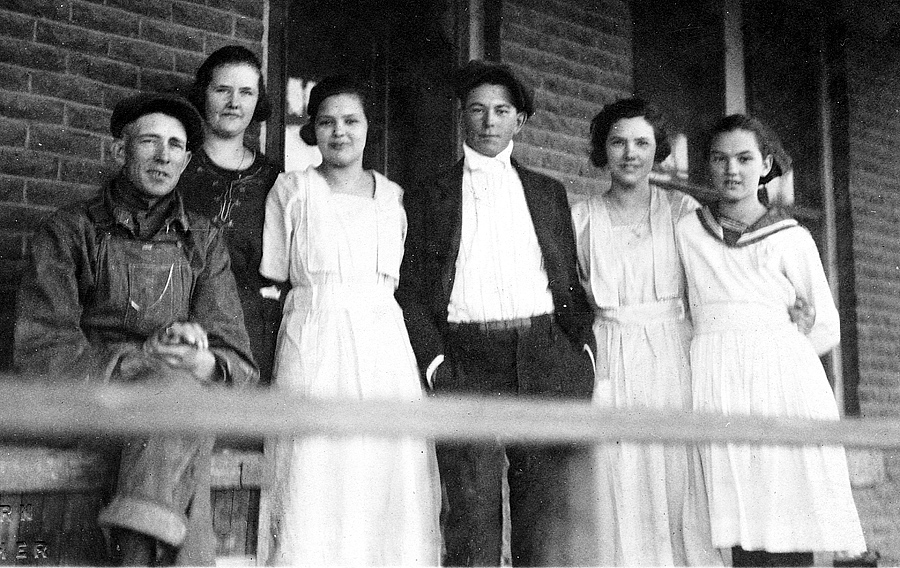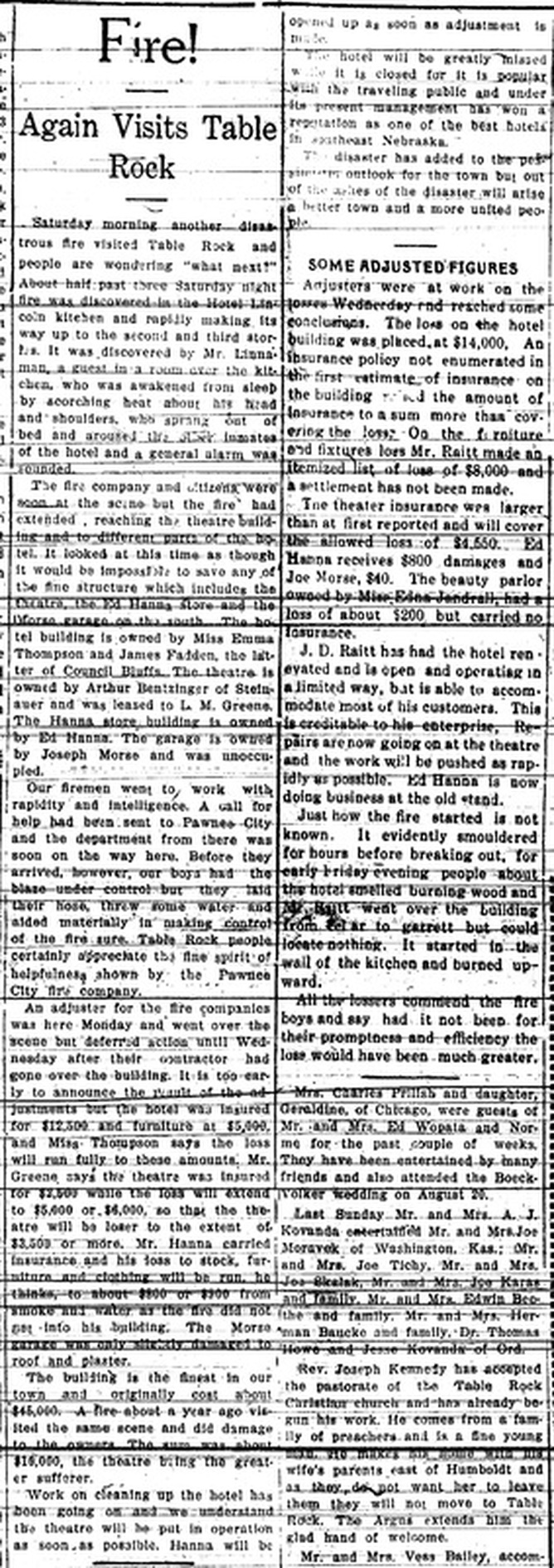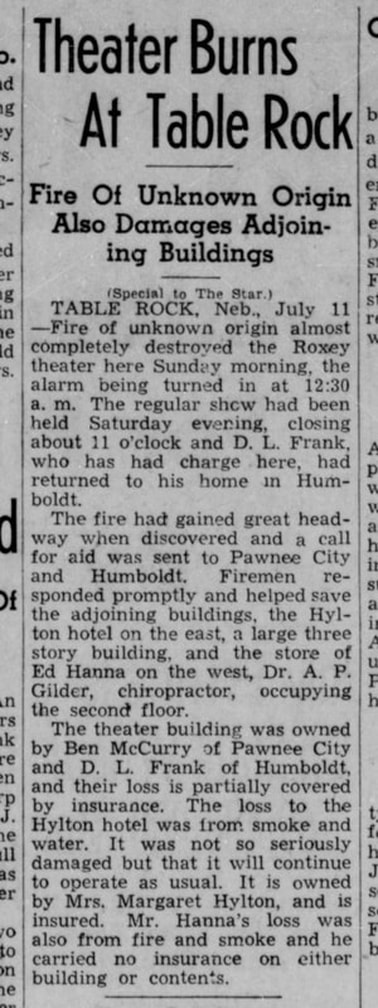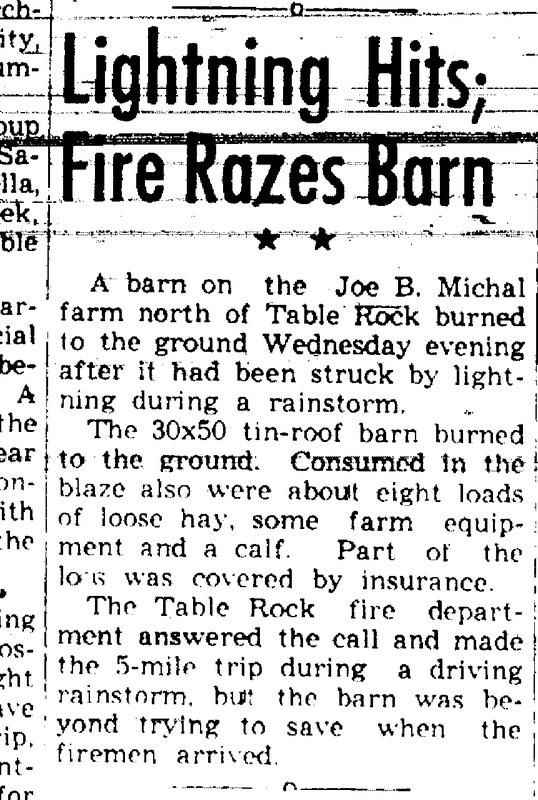fires in table rock
1876
Reported in a paper other than the Argus, which was not founded until1882, "many houses were carried away" in this May 1876 flood, and half a railroad car of lime caught fire.
a mention of an 1880 fire -- intended to reference the 1876 fire?
In 1957, Nettie Stehlik wrote an extensive history of the Pleasant Valley Country School. It included much local history for context. In the July 4 installment, she mentioned the fire of 1880, which burned down much of Lower Town. It may be that the subject was to the 1876 fire, given the reference to a fire caused by lime.
june 3, 1891 columbus journal
fire at the home of wm. boggs
a lamp exploded
june 17, 1896 -
the argus newspaper office a total loss
april 6, 1899
fire at t. w. conklin's home
lamp exploded
august 12, 1899
omaha daily bee
a string of freight cars catches fire
january 4, 1900
the restaurant of capt. r. p. jennings
november 9, 1900
emily fisher's barn
in which were stored many new buggies owned by retailer william white
the new odd fellows building burns down - january 1901
the "big" fire - february 6, 1920
relevant events prior to the big fire
Some newspaper articles five years before the fire -- all on October 29, 1915 provide some interesting context.
For example, the big fire in 1926 began in the Belshaw Pharmacy. They did not know the cause. Curiously, five years before the 1920 fire, the Belshaw Pharmacy had a new-fangled furnace installed.
Ironically, school children were taught fire prevention, in part so they could bring that knowledge to the business world to decrease the "great unnecessary fire loss."
The Table Rock Volunteer Fire Department was quite excited that they might get a chance to fire a "real fire," hooked up their new "chemical" engine to a car, and drove "at the rate of nearly 30 miles an hour" toward Dubois, until meeting folks who gave them the news that the fire was already out.
The volunteer fire department's pride in its chemical engine aside, the volunteers reportedly became lax during WW1 and after.
For example, the big fire in 1926 began in the Belshaw Pharmacy. They did not know the cause. Curiously, five years before the 1920 fire, the Belshaw Pharmacy had a new-fangled furnace installed.
Ironically, school children were taught fire prevention, in part so they could bring that knowledge to the business world to decrease the "great unnecessary fire loss."
The Table Rock Volunteer Fire Department was quite excited that they might get a chance to fire a "real fire," hooked up their new "chemical" engine to a car, and drove "at the rate of nearly 30 miles an hour" toward Dubois, until meeting folks who gave them the news that the fire was already out.
The volunteer fire department's pride in its chemical engine aside, the volunteers reportedly became lax during WW1 and after.
On the night of February 5, 1920, folks went to bed with their town having quite a number of thriving businesses. Many were located on the South side of the Square, west of the new Lincoln Hotel Block. That "block" of buildings -- the hotel, theater, and a retail store -- had been built in 1916 - 1917.
Here are pictures of the South side businesses prior to the fire. (These were taken over the years and none were taken as late as 1920.)
Here are pictures of the South side businesses prior to the fire. (These were taken over the years and none were taken as late as 1920.)
Photo 409
Photo 405:
Photo 462:
Photo 467:
Photo 468:
Photo 465:
Photo 259:
Here is what Table Rock residents woke up to see of the South side business district. Note that the frame buildings east of the fire are still standing. However, one was taken out when the brick wall next to it fell on it, and the others were dynamited to protect the Lincoln Hotel Block buildings:
Photo 486:
Photo 862:
Here is the lay of the land just prior to the fire:
On the East end was the new Lincoln Hotel Building Block built in 1916, a complex which included a hotel, a theater, and a store building.
On the west end were the two buildings now occupied by Table Rock Electric and the Argus Museum of the Table Rock Historical Society. The former was the Richardson Building, the latter was the Taylor Building. Both were built in the 1890s.
Between were a variety of buildings, six of brick and others frame.
The six brick buildings, not necessarily in order:
1) The W. H. Wilson “Block,” a building with multiple establishments and a living quarters. On the ground floor, on the east and west sides of it were the Belshaw Pharmacy -- which often advertised goldfish for sale -- and the Basket Store. R. C. Cotton had a jewelry store within the Belshaw Pharmacy but was in the process of moving to the block west of the south side. James Walker lived on the second floor of the Wilson building.
2) To the west of the Wilson Block was the Frank. Kovanda building, which was occupied by Norris Aylor’s store.
3) The lavish establishment of W. C. Fellers
4) The Beustett Block, a building that contained Wilson’s store on the first floor, and a lodge hall (the A.O.U.W.) on the second floor.
5) The Purcell Block, a building that had J. L. Fulton’s billiard hall on the first floor, and the Belshaw Hall above.
6) The J. C. Beck building, which housed J. B. Carter’s store.
There were three frame buildings.
1) A building owned by Mary Chandler of Steinauer and occupied by the Frank Sherman Barber Shop.
2) A building owned by James Tank and occupied by Mrs. Martin’s Millinery Shop
3) A building owned by F. A. Steah and J. N. Phillips, which may have been unoccupied.
All of the buildings between the Lincoln Hotel Block and Table Rock Electric were lost in the fire.
All.
The people of Table Rock went to bed with a block of businesses and woke up – if they slept through the hubub -- to rubble.
The six brick buildings in the middle of the block burned overnight.
The frame buildings of Chandler and Tenk had been torn down (some say dynamited) to keep the fire from spreading the Lincoln Hotel Block.
The frame building of Steah and Phillips was standing at day break, but at Noon, the west wall of the Purcell building was dynamited and fell on it, crushing it.
Within the year, four buildings had returned.
In the middle of the block, Jim Purcell rebuilt. He had a general merchandise concern. The building was later occupied on the east side by Karas by Knapp’s Grocery Store and Vrtiska Electric.
West of Purcell, on the other side of a fire hole, J. C. Beck rebuilt. That building was most recently occupied by the Saddle Rock Tavern.
West of Beck, Frank Kovanda rebuilt. That building was occupied by a mortuary for many years, but most recently the Saddle Rock Tavern extended into it.
After many decades, the Table Rock Apartments, the Post Office, and the Telephone Building were located in the fire holes on either side of the Purcell Building, and a small building was built onto the east side of the Purcell Building that once housed Jim Karas’s welding shop and later John Kolacney’s business.
On the East end was the new Lincoln Hotel Building Block built in 1916, a complex which included a hotel, a theater, and a store building.
On the west end were the two buildings now occupied by Table Rock Electric and the Argus Museum of the Table Rock Historical Society. The former was the Richardson Building, the latter was the Taylor Building. Both were built in the 1890s.
Between were a variety of buildings, six of brick and others frame.
The six brick buildings, not necessarily in order:
1) The W. H. Wilson “Block,” a building with multiple establishments and a living quarters. On the ground floor, on the east and west sides of it were the Belshaw Pharmacy -- which often advertised goldfish for sale -- and the Basket Store. R. C. Cotton had a jewelry store within the Belshaw Pharmacy but was in the process of moving to the block west of the south side. James Walker lived on the second floor of the Wilson building.
2) To the west of the Wilson Block was the Frank. Kovanda building, which was occupied by Norris Aylor’s store.
3) The lavish establishment of W. C. Fellers
4) The Beustett Block, a building that contained Wilson’s store on the first floor, and a lodge hall (the A.O.U.W.) on the second floor.
5) The Purcell Block, a building that had J. L. Fulton’s billiard hall on the first floor, and the Belshaw Hall above.
6) The J. C. Beck building, which housed J. B. Carter’s store.
There were three frame buildings.
1) A building owned by Mary Chandler of Steinauer and occupied by the Frank Sherman Barber Shop.
2) A building owned by James Tank and occupied by Mrs. Martin’s Millinery Shop
3) A building owned by F. A. Steah and J. N. Phillips, which may have been unoccupied.
All of the buildings between the Lincoln Hotel Block and Table Rock Electric were lost in the fire.
All.
The people of Table Rock went to bed with a block of businesses and woke up – if they slept through the hubub -- to rubble.
The six brick buildings in the middle of the block burned overnight.
The frame buildings of Chandler and Tenk had been torn down (some say dynamited) to keep the fire from spreading the Lincoln Hotel Block.
The frame building of Steah and Phillips was standing at day break, but at Noon, the west wall of the Purcell building was dynamited and fell on it, crushing it.
Within the year, four buildings had returned.
In the middle of the block, Jim Purcell rebuilt. He had a general merchandise concern. The building was later occupied on the east side by Karas by Knapp’s Grocery Store and Vrtiska Electric.
West of Purcell, on the other side of a fire hole, J. C. Beck rebuilt. That building was most recently occupied by the Saddle Rock Tavern.
West of Beck, Frank Kovanda rebuilt. That building was occupied by a mortuary for many years, but most recently the Saddle Rock Tavern extended into it.
After many decades, the Table Rock Apartments, the Post Office, and the Telephone Building were located in the fire holes on either side of the Purcell Building, and a small building was built onto the east side of the Purcell Building that once housed Jim Karas’s welding shop and later John Kolacney’s business.
what happened?
The February 7, 1920 edition of the Argus carried a front page story. The PDF of that article is very difficult to read. However, it was reprinted in the Argus on the 40th anniversary of the fire in 1960.
Here is the original article:
The February 13, 1920 edition of the Argus gave an update:
An update two weeks after the fire, on February 27, 1920 talks about volunteers appearing to clear away the debris of the fire:
March 1920. Some of the merchants are going to rebuild: Kovanda, Beck, Fellers, Phillips, and Purcell. (In the end only Kovanda, Beck, and Purcell did so. Kovanda's building is on the south side of Table Rock Electric and once was Wherry's Mortuary. Beck's Building most recently housed the Saddle Rock Tavern. Purcell's building is gone, but at different times it housed Knapp's grocery store and Gary Vrtiska's electrical business.)
March 1920. Wilson decides not to rebuild:
Cotton, a merchant who had moved a block west. ran an ad praising the rebuilding efforts:
A study of Photo 862:
after the rebuilding, the south side square remained incomplete for many years.
Photo 375:
Photo 475. Purcell's store can be seen in the middle of the block, between groups of trees. There is a small building attached to it, believed to have been built by Rudy Karas as a blacksmith shop. In the foreground are the two buildings on the west end of the street that survived the fire, the buildings rebuilt by Kovanda and Beck, and, the Purcell store.
january 1930
big fire at the brace garage
later the karas garage then sitzman repair
The Brace Garage was a two-story brick building, with a residential apartment over the office and show rooms in the front. It had previously been used as a livery, then converted for use as an automobile repair garage and creamery. Later, Rudy Karas operated a garage and sold cars for many year. The garage currently houses Sitzman Repair. All that is left is the two-story portion with the second-floor apartment. After the 1930 fire, the second story behind the residence was removed. On February 1, 1989, another fire occurred which wiped out that first floor as well.
february 1930 - fire in the movie theater
A fire started in the Theater on February 28, 1930. Losses were heavy, with the screen and curtains destroyed. There was great smoke damage to all of the rooms in the adjoining hotel as well.
March 6, 1930:
march 6, 1931
the grand hotel murphy burns
On March 6, 1931, the Hotel Murphy burned down. The Murphy Hotel was a beautiful, grand railroad hotel. It was approximately where the Reno Inn is now. When was it built? An article about the fire gave the history of the hotel and said that it had operated "with the coming of the railroad." The railroad came in 1871. It was thus probably 70 years old at the time of the fire.
Photo 14:
Photo 242:
As with the fire in 1920, the fire fighting resources were nil. The town system had no water pressure. Here is the March 6, 1931 article about the fire:
The Hotel Murphy burned on Monday night. The son of the owner of the Hotel Murphy owned a cottage behind the hotel. The day after the hotel fire, the cottage burned down, too.
Photo 243 - some members of the Shepherd family at the hotel.
May 1931. Shepherd immediately rebuilds. This is almost certainly the building that eventually was known as the Reno Inn:
august 1931
Another theater fire occurred on August 28, 1931:
july 11, 1938 nebraska state journal
roxey theater nearly completely destroyed
hotel & edd hanna's store saved
february 23, 1956
glen kent's barn & granary
July 5, 1956:
August 8, 1957:
January 1, 1959. Catastrophic fire destroys the home of an elderly couple and everything in it. They did not have a phone and Mrs. Hanna had to run for help. By the time the Fire Department arrived the fire could not be brought under control. She was treated at the Humboldt hospital for shock:

